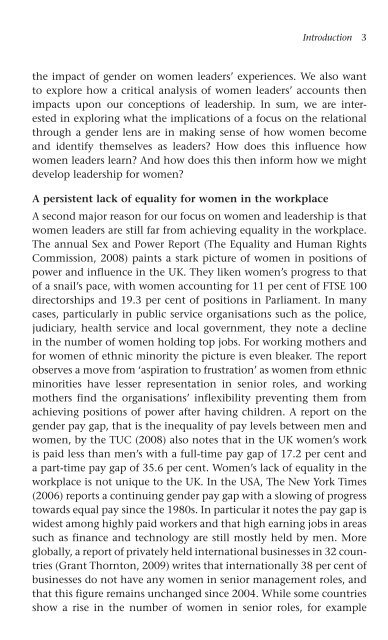Women's Leadership
Women's Leadership
Women's Leadership
You also want an ePaper? Increase the reach of your titles
YUMPU automatically turns print PDFs into web optimized ePapers that Google loves.
Introduction 3<br />
the impact of gender on women leaders’ experiences. We also want<br />
to explore how a critical analysis of women leaders’ accounts then<br />
impacts upon our conceptions of leadership. In sum, we are interested<br />
in exploring what the implications of a focus on the relational<br />
through a gender lens are in making sense of how women become<br />
and identify themselves as leaders? How does this influence how<br />
women leaders learn? And how does this then inform how we might<br />
develop leadership for women?<br />
A persistent lack of equality for women in the workplace<br />
A second major reason for our focus on women and leadership is that<br />
women leaders are still far from achieving equality in the workplace.<br />
The annual Sex and Power Report (The Equality and Human Rights<br />
Commission, 2008) paints a stark picture of women in positions of<br />
power and influence in the UK. They liken women’s progress to that<br />
of a snail’s pace, with women accounting for 11 per cent of FTSE 100<br />
directorships and 19.3 per cent of positions in Parliament. In many<br />
cases, particularly in public service organisations such as the police,<br />
judiciary, health service and local government, they note a decline<br />
in the number of women holding top jobs. For working mothers and<br />
for women of ethnic minority the picture is even bleaker. The report<br />
observes a move from ‘aspiration to frustration’ as women from ethnic<br />
minorities have lesser representation in senior roles, and working<br />
mothers find the organisations’ inflexibility preventing them from<br />
achieving positions of power after having children. A report on the<br />
gender pay gap, that is the inequality of pay levels between men and<br />
women, by the TUC (2008) also notes that in the UK women’s work<br />
is paid less than men’s with a full-time pay gap of 17.2 per cent and<br />
a part-time pay gap of 35.6 per cent. Women’s lack of equality in the<br />
workplace is not unique to the UK. In the USA, The New York Times<br />
(2006) reports a continuing gender pay gap with a slowing of progress<br />
towards equal pay since the 1980s. In particular it notes the pay gap is<br />
widest among highly paid workers and that high earning jobs in areas<br />
such as finance and technology are still mostly held by men. More<br />
globally, a report of privately held international businesses in 32 countries<br />
(Grant Thornton, 2009) writes that internationally 38 per cent of<br />
businesses do not have any women in senior management roles, and<br />
that this figure remains unchanged since 2004. While some countries<br />
show a rise in the number of women in senior roles, for example
















